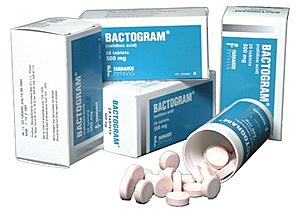Nalidixic acid
Questions
| Reviews 




nalidixic
Can Nalidixic be taken if one has Dysentery or Diarrhea disease?
by chrispin banda in Lusaka, Zambia, 10/13/2017
Effect of Naldixic acid
Role of Naldixic acid in bacterial protease & gelatinase production
by Sudha in Chennai, 08/19/2007
Mode of Action of Nalidixic Acid
How can Nalidixic Acid interfere DNA polymerization? What are the enzymes inhibited by nalidixic acid for inhibiting DNA synthesis?
by Criz Andrada in Manila, Philippines, 09/19/2006
Is Nal. Acid still available in the US?
Hello. I am doing a paper on Nalidixic Acid, and a few websites mention that it is no longer available as a prescription drug in the US, but others dont mention anything about it. I was hoping that you could tell me whether this is true or not, and if...
by Danielle in Chicago, IL, 07/11/2006
|
Classification: Urinary germicide
Action/Kinetics:
Thought to inhibit the DNA synthesis, probably by interfering with DNA polymerization. Is either bacteriostatic or bactericidal. Rapidly absorbed from the GI tract.
Peak plasma concentration: 20-40 mcg/mL after 1-2 hr;
peak urine levels: 150-200 mcg/mL after 3-4 hr.
t
1/2, plasma: 1.5 hr (increased to 21 hr in anuric clients);
t
1/2, urine: 6 hr. Metabolized in the liver to hydroxynalidixic acid (comparable activity to nalidixic acid) and inactive compounds which are rapidly excreted. Extensively protein bound.
Uses: Acute and chronic UTIs caused by susceptible gram-negative organisms, including Escherichia coli, Proteus, Enterobacter and Klebsiella. Contraindications: Lactation. Use in infants less than 3 months of age. Special Concerns: Use with caution in prepubertal children, clients with liver disease, severely impaired kidney function, epilepsy, and severe cerebral arteriosclerosis. Side Effects: GI: N&V;, diarrhea, abdominal pain. CNS: Drowsiness, headache, dizziness, weakness, vertigo, toxic psychoses, intracranial hypertension, seizures (rare). Also, increased intracranial pressure with bulging anterior fontanel, papilledema, and headache; sixth cranial nerve palsy in children and infants. Allergic: Photosensitivity (e.g., erythema, painful bullae on exposed skin), skin rashes, arthralgia (joint swelling and stiffness), pruritus, urticaria, angioedema, eosinophilia, anaphylaxis (rare). Hematologic: Leukopenia, thrombocytopenia, hemolytic anemia (especially in clients with G6PD deficiency). Ophthalmic: Reversible subjective visual disturbances, including overbrightness of lights, difficulty in focusing, changes in color perception, double vision, decreased visual acuity. Other: Metabolic acidosis, cholestatic jaundice, cholestasis, paresthesia. Laboratory Test Alterations: False + for urinary glucose with Benedict's solution, Fehling's solution, or Clinitest Reagent tablets. Falsely elevated 17-ketosteroids. Overdose Management: Symptoms: Toxic psychoses, convulsions, increased intracranial pressure, nausea, vomiting, lethargy, metabolic acidosis. Treatment: Gastric lavage if the overdose is identified early. If absorption has occurred, fluid administration is increased with supportive measures. In severe cases, use of anticonvulsants may be necessary.
Drug Interactions:
How Supplied: Suspension: 250 mg/5 mL; Tablet: 250 mg, 500 mg, 1 g
Dosage
|



3 comments | Reply